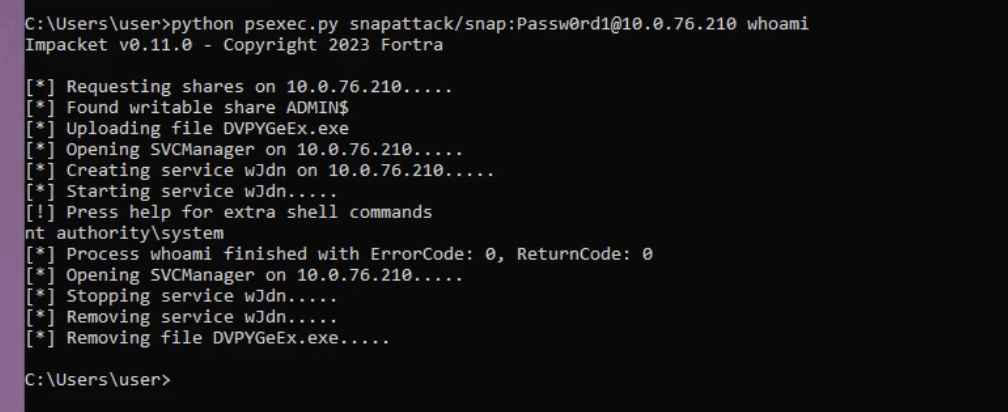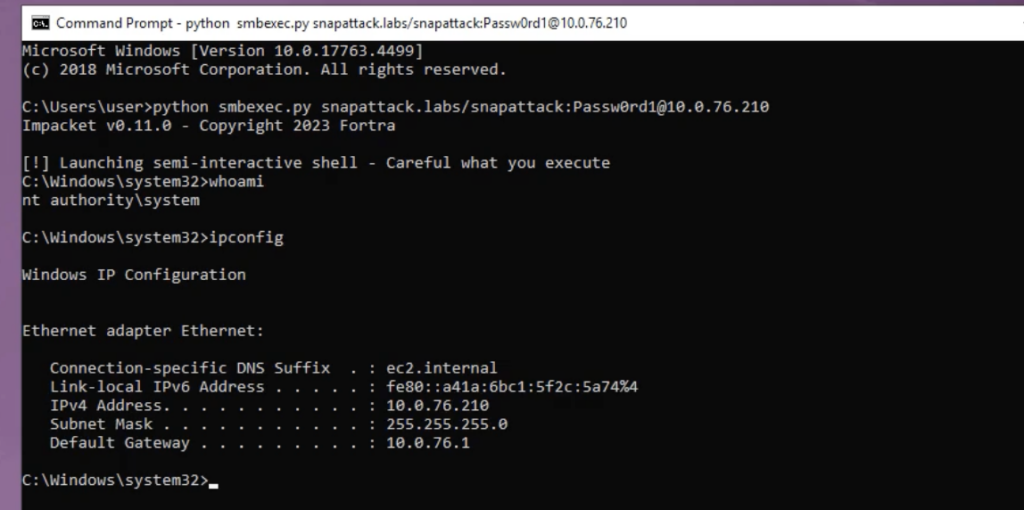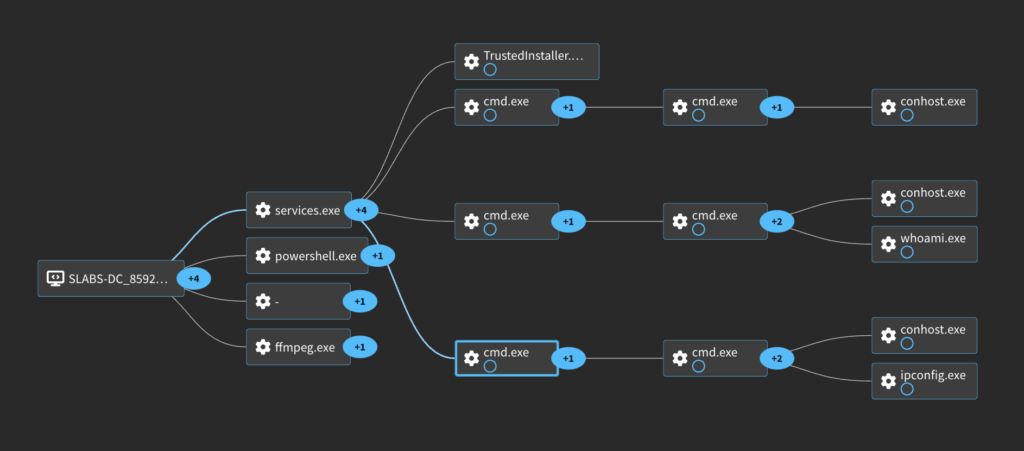Impacket Overview
Featured Protocols
- Ethernet
- IP (IPv4 and IPv6), TCP, UDP, ICMP, IGMP, ARP.
- NMB and SMB1, SMB2 and SMB3
- MSRPC version 5 over TCP, SMB/TCP, SMB/NetBIOS and HTTP.
- Plain, NTLM and Kerberos authentications (via various mechanisms)
- The following MSRPC interfaces: EPM, DTYPES, LSAD, LSAT, NRPC, RRP,
SAMR, SRVS, WKST, SCMR, BKRP, DHCPM, EVEN6, MGMT, SASEC, TSCH, DCOM,
WMI, OXABREF, NSPI, OXNSPI. - Portions of TDS (MSSQL) and LDAP protocol implementations.
Example Scripts

Remote Command Execution
Implements PSEXEC like functionality using RemComSvc. PsExec works by copying a system executable to the remote machine and then instructing the Windows Service Control Manager to run that service. This process allows command execution on the remote machine by creating a named pipe that the service uses to communicate back to the PsExec client, facilitating input and output redirection.
A similar approach to PSEXEC without using RemComSvc. This implementation instantiates local smbserver to receive the output of the commands. This is useful in the situation where the target machine does NOT have a writeable share available.
This example implements methods to run remote code via creating, enumerating, running, and deleting jobs using the task scheduler service.
wmiexec.py:
Uses a similar approach to smbexec but executing commands through WMI. Main advantage here is it runs under the Admin account, not SYSTEM, plus, it doesn’t generate noisy messages in the event log that smbexec.py does when creating a service. Drawback is it needs DCOM.
dcomexec.py:
Similar to wmiexec.py using other DCOM endpoints.
Leverages the Windows Management Instrumentation (WMI) to establish persistence on a compromised Windows machine. It does this by creating a WMI event subscription, which executes a given payload (such as a command or script) when specified system events occur, enabling attackers to maintain access to the system across reboots without needing traditional auto-start methods.
Psexec.py


The first event to look at is Windows Event 5145. This is when a network share object was checked to see whether client can be granted desired access. This event indicates an attempt to access a shared resource, like a file or a named pipe on the network. In psexec’s case this will be the writeable share it finds. Here we can see it attempting to write the service executable to the C:\Windows path using the ADMIN$ share. The Access List here (%%4417) is for WriteData (or AddFile). For a file object, it requests the right to write data to the file. For a directory object, the right to create a file in the directory.
EventCode: 5145
AccessList: %%4417
ObjectType: File
ProcessId: 4
RelativeTargetName: DVPYGeEx.exe
ShareLocalPath: \\?\C:\Windows
ShareName: \\*\ADMIN$
After the service executable is staged, it will attempt to create the service it uses. WIndows Event 4697 documents when a service is installed on the system. Of interest here is the Client and Parent ProcessId’s being 0. We can also see it points to the service executable written earlier with a manual start (3) and a Service Type of 10, which is a Win32 program that can be started by the Service Controller and that obeys the service control protocol.
EventCode: 4697
ClientProcessId: 0
ParentProcessId: 0
ServiceName: wJdn
ServiceFileName: %systemroot%\DVPYGeEx.exe
ServiceStartType: 3
ServiceAccount: LocalSystem
ServiceType: 10
You can also see the service installation via Event 7045, which denotes when a remote service is installed on the system.
EventCode: 7045
EventSourceName: "Service Control Manager"
ServiceType: user mode service
StartType: demand start
ImagePath: %systemroot%\DVPYGeEx.exe
EventCode: 13
EventType: SetValue
ProcessName: services.exe
TargetObject: HKLM\System\CurrentControlSet\Services\wJdn\ImagePath
Details: %%systemroot%%\DVPYGeEx.exe
EventCode: 18
EventType: ConnectPipe
ProcessId: 4
PipeName: \RemCom_communicaton
User: NT AUTHORITY\SYSTEM
EventCode: 18
EventType: ConnectPipe
ProcessId: 4
PipeName: \RemCom_stdinCrFu8456
User: NT AUTHORITY\SYSTEM
EventCode: 18
EventType: ConnectPipe
ProcessId: 4
PipeName: \RemCom_stdoutCrFu8456
User: NT AUTHORITY\SYSTEM
EventCode: 18
EventType: ConnectPipe
ProcessId: 4
PipeName: \RemCom_stderrCrFu8456
User: NT AUTHORITY\SYSTEM
EventCode: 1
CommandLine: whoami
ParentImage: C:\Windows\DVPYGeEx.exe
User: NT AUTHORITY\SYSTEM
For more logs and details, we have captured this activity in our platform: Impacket PSEXEC
For Detections check out this Collection: Hunting Impacket PSEXEC
MITRE
T1021.002: Remote Services: SMB/Windows Admin Shares
Adversaries may use valid accounts to interact with a remote network share using Server Message Block (SMB).
T1059.006: Command and Scripting Interpreter: Python **
Adversaries may abuse Python commands and scripts for execution.
T1078: Valid Accounts
Adversaries may obtain and abuse credentials of existing accounts as a means of gaining Initial Access, Persistence, Privilege Escalation, or Defense Evasion.
T1543.003: Create or Modify System Process: Windows Service
Adversaries may create or modify Windows services to repeatedly execute malicious payloads as part of persistence.
T1543: Create or Modify System Process
Adversaries may create or modify system-level processes to repeatedly execute malicious payloads as part of persistence.
T1569.002: System Services: Service Execution
Adversaries may abuse the Windows service control manager to execute malicious commands or payloads.
T1570: Lateral Tool Transfer
Adversaries may transfer tools or other files between systems in a compromised environment.
Smbexec.py


EventCode: 7045
EventSourceName: "Service Control Manager"
ServiceType: user mode service
StartType: demand start
ImagePath: %COMSPEC% /Q /c echo whoami ^> \\%COMPUTERNAME%\C$\__output 2^>^&1 > %SYSTEMROOT%\HziVFHQH.bat & %COMSPEC% /Q /c %SYSTEMROOT%\HziVFHQH.bat & del %SYSTEMROOT%\HziVFHQH.bat
EventCode: 13
EventType: SetValue
ProcessName: services.exe
TargetObject: HKLM\System\CurrentControlSet\Services\JwkuauZg\ImagePath
Details: %%COMSPEC%% /Q /c echo whoami ^> \\%%COMPUTERNAME%%\C$\__output 2^>^&1 > %%SYSTEMROOT%%\HziVFHQH.bat & %%COMSPEC%% /Q /c %%SYSTEMROOT%%\HziVFHQH.bat & del %%SYSTEMROOT%%\HziVFHQH.bat
EventCode: 1
ParentProcessName: services.exe
CommandLine: C:\Windows\system32\cmd.exe /Q /c echo whoami ^> \\SLABS-DC\C$\__output 2^>^&1 > C:\Windows\HziVFHQH.bat & C:\Windows\system32\cmd.exe /Q /c C:\Windows\HziVFHQH.bat & del C:\Windows\HziVFHQH.bat
User: NT AUTHORITY\SYSTEM
For more logs and details, we have captured this activity in our platform: Impacket SMBExec
For Detections check out this Collection: Hunting Impacket SMBEXEC
MITRE
T1021.002: Remote Services: SMB/Windows Admin Shares
Adversaries may use valid accounts to interact with a remote network share using Server Message Block (SMB).
T1059.006: Command and Scripting Interpreter: Python
Adversaries may abuse Python commands and scripts for execution.
T1078: Valid Accounts
Adversaries may obtain and abuse credentials of existing accounts as a means of gaining Initial Access, Persistence, Privilege Escalation, or Defense Evasion.
T1543.003: Create or Modify System Process: Windows Service
Adversaries may create or modify Windows services to repeatedly execute malicious payloads as part of persistence.
T1543: Create or Modify System Process
Adversaries may create or modify system-level processes to repeatedly execute malicious payloads as part of persistence.
T1569.002: System Services: Service Execution
Adversaries may abuse the Windows service control manager to execute malicious commands or payloads.
Atexec.py


Since this tool utilizes the task scheduler for its technique the first place to look for detection opportunities is going to be the task being created with Windows Event 4698. Here you will see the command arguments written to a temp file. Note that it is being set to run at the system level context with RunLevel HighestAvailable.
EventCode: 4698
Arguments: /C whoami \> %windir%\Temp\vfIUxfly.tmp 2>&1
Command: cmd.exe
Context: LocalSystem
LogonType: InteractiveToken
RunLevel: HighestAvailable
Principal: LocalSystem
AllowStartOnDemand: TRUE
Enabled: TRUE
Hidden: TRUE
Priority: 7
TaskName: \vfIUxfly
<?xml version="1.0" encoding="UTF-16"?>
<Task version="1.2" xmlns="http://schemas.microsoft.com/windows/2004/02/mit/task">
<Triggers>
<CalendarTrigger>
<StartBoundary>2015-07-15T20:35:13.2757294</StartBoundary>
<Enabled>true</Enabled>
<ScheduleByDay>
<DaysInterval>1</DaysInterval>
</ScheduleByDay>
</CalendarTrigger>
</Triggers>
<Principals>
<Principal id="LocalSystem">
<UserId>S-1-5-18</UserId>
<RunLevel>HighestAvailable</RunLevel>
</Principal>
</Principals>
<Settings>
<MultipleInstancesPolicy>IgnoreNew</MultipleInstancesPolicy>
<DisallowStartIfOnBatteries>false</DisallowStartIfOnBatteries>
<StopIfGoingOnBatteries>false</StopIfGoingOnBatteries>
<AllowHardTerminate>true</AllowHardTerminate>
<RunOnlyIfNetworkAvailable>false</RunOnlyIfNetworkAvailable>
<IdleSettings>
<StopOnIdleEnd>true</StopOnIdleEnd>
<RestartOnIdle>false</RestartOnIdle>
</IdleSettings>
<AllowStartOnDemand>true</AllowStartOnDemand>
<Enabled>true</Enabled>
<Hidden>true</Hidden>
<RunOnlyIfIdle>false</RunOnlyIfIdle>
<WakeToRun>false</WakeToRun>
<ExecutionTimeLimit>P3D</ExecutionTimeLimit>
<Priority>7</Priority>
</Settings>
<Actions Context="LocalSystem">
<Exec>
<Command>%s</Command>
<Arguments>%s</Arguments>
</Exec>
</Actions>
</Task>
EventCode: 1
CommandLine: cmd.exe /C whoami > C:\Windows\Temp\vfIUxfly.tmp 2>&1
ParentCommandLine: C:\Windows\system32\svchost.exe -k netsvcs -p -s Schedule
User: NT AUTHORITY\SYSTEM
EventCode: 11
User: NT AUTHORITY\SYSTEM
Image: C:\Windows\system32\cmd.exe
TargetFilename: C:\Windows\Temp\vfIUxfly.tmp
EventCode: 5145
AccessList: %%4416
ObjectType: File
ProcessId: 4
RelativeTargetName: Temp\vfIUxfly.tmp
ShareLocalPath: \\?\C:\Windows
ShareName: \\\*\ADMIN\$
EventCode: 4699
TaskName: \vfIUxfly
Name: A scheduled task was deleted
For more logs and details, we have captured this activity in our platform: Impacket AtExec
For Detections check out this Collection: Hunting Impacket ATEXEC
MITRE
T1021: Remote Services
Adversaries may use valid accounts to log into a service that accepts remote connections, such as telnet, SSH, and VNC.
T1053.002: Scheduled Task/Job: At
Adversaries may abuse the at utility to perform task scheduling for initial or recurring execution of malicious code.
T1059.006: Command and Scripting Interpreter: Python
Adversaries may abuse Python commands and scripts for execution.
T1059: Command and Scripting Interpreter
Adversaries may abuse command and script interpreters to execute commands, scripts, or binaries.
T1078: Valid Accounts
Adversaries may obtain and abuse credentials of existing accounts as a means of gaining Initial Access, Persistence, Privilege Escalation, or Defense Evasion.
Conclusion
SnapAttack is the threat hunting, detection engineering, and detection validation platform for proactive threat-informed defense. Register for a FREE community account to access the tons of content included in this blog post, as well as thousands of other community detections. Subscribers also get advanced features like a no-code detection builder, one-click deployments to leading SIEMs and EDRs like Chronicle, Sentinel, Splunk, CrowdStrike and SentinelOne, advanced threat profiles to prioritize relevant threats, and customized reports that track MITRE ATT&CK coverage and more!
About SnapAttack: SnapAttack is an innovator in proactive, threat-informed security solutions. The SnapAttack platform helps organizations answer their most pressing question: “Are we protected against the threats that matter?”
By rolling threat intelligence, adversary emulation, detection engineering, threat hunting, and purple teaming into a single, easy-to-use product with a no-code interface, SnapAttack enables companies to get more from their tools and more from their teams so they can finally stay ahead of the threat.




